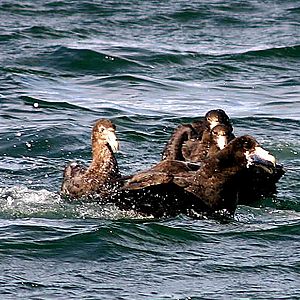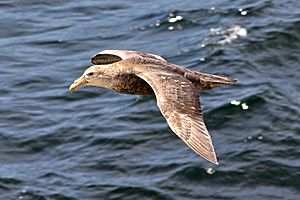Southern giant petrel facts for kids
Quick facts for kids Southern giant petrel |
|
|---|---|
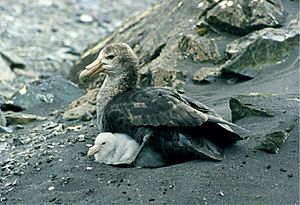 |
|
| Adult and chick | |
| Conservation status | |
| Scientific classification | |
| Genus: |
Macronectes
|
| Species: |
giganteus
|
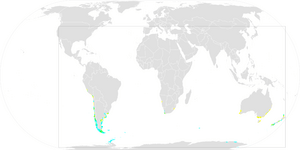 |
|
| Global map of eBird reports Year-Round Range Summer Range Winter Range | |
The southern giant petrel (Macronectes giganteus) is a very large seabird that lives in the southern parts of the world's oceans. People also call it the Antarctic giant petrel, giant fulmar, stinker, or stinkpot.
This bird shares its home with the similar northern giant petrel. You can tell them apart by looking at the tip of their beaks. The southern giant petrel has a green tip, while the northern one has a reddish tip.
Contents
About the Southern Giant Petrel
What's in a Name?
The scientific name for this bird is Macronectes giganteus. This name comes from ancient languages.
Makros is a Greek word meaning "long" or "large". Nēktēs means "swimmer". So, Macronectes means "large swimmer".
Giganteus comes from Latin and means "gigantic" or "very big".
The name "southern giant petrel" tells us that this bird lives further south than its cousin, the northern giant petrel. The word "petrel" comes from St. Peter walking on water. This refers to how these birds seem to run on the water when they take off.
They were also called "fulmar." This name comes from an Old Norse word meaning "foul gull." They look a bit like seagulls. They can also spit a yucky, bad-smelling liquid at predators to defend themselves.
How to Spot a Southern Giant Petrel
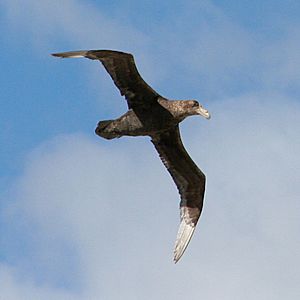
Southern giant petrels are the biggest birds in their family, the Procellariidae. They can be from 86 to 99 centimeters (34 to 39 inches) long. Their wings can spread out from 185 to 205 centimeters (73 to 81 inches) wide.
These birds can weigh between 2.3 and 5.6 kilograms (5.1 to 12.3 pounds). Males are usually bigger than females.
They have a very large yellow bill with a green tip. Their legs are greyish-brown.
There are two main types, or morphs, of southern giant petrels:
- Dark morph: This type looks similar to the northern giant petrel. Their upper chest, head, and neck are light. The rest of their body is mottled brown. The front edge of their wings and the base of their inner primaries are lighter underneath.
- Light morph: This type is rarer and stands out more. It's almost all white with only a few black speckles.
Young dark morph birds start off a sooty brown color and get lighter as they grow older. Both types of giant petrels have strong legs. This helps them move around well on land. When they fly, they look a bit hunchbacked.
Special Bird Features
Like all birds in their group (Procellariiformes), southern giant petrels have unique features:
- Nose Tubes: They have special nasal passages called naricorns. These are tubes that attach to the top of their bill. Their nostrils are on top of the bill, not on the sides.
- Unique Bills: Their bills are made of 7 to 9 horny plates. This is different from other birds.
- Stomach Oil: They can produce a special stomach oil. This oil is stored in their stomach. They can spray it out of their mouths to defend themselves from predators. It's also a rich food source for their chicks and for the adults during long flights.
- Salt Gland: They have a salt gland above their nasal passage. This gland helps remove salt from their blood. They get a lot of salt from the ocean water they drink and the marine animals they eat. The gland gets rid of this salt by releasing a salty solution from their nostrils.
Southern Giant Petrel Life Cycle
Reproduction
Southern giant petrels are ready to have chicks when they are six or seven years old. However, most of them start breeding when they are about ten years old.
Their breeding season starts in October. They build their nests on bare or grassy ground. The nest is a mound made of moss, grass, and stones, with a dip in the middle.
They usually form small colonies. But in the Falkland Islands, their colonies can be much larger.
The female lays one pure white egg. It is about 103 by 70 millimeters (4.1 by 2.8 inches) in size. Both parents take turns incubating the egg for 55 to 66 days. One parent always guards the egg.
When the white chick hatches, the parents keep it warm for two to three weeks. The chick then fledges, or learns to fly, when it is 104 to 132 days old.
Feeding Habits
This petrel eats many different things. It feeds on fish, krill, squid, and even offal (animal guts) and waste from boats. They often follow fishing boats and cruise ships in coastal and open ocean waters.
Unlike most other birds in its group, the southern giant petrel also eats carrion, which is dead animals.
These birds are very aggressive hunters. They will kill other seabirds, especially:
- Penguin chicks
- Sick or injured adult penguins
- Chicks of other seabirds
They have even been seen drowning adult Australasian gannets by holding them underwater. They have also drowned yellow-nosed and black-browed albatrosses. When they are feeding on dead animals, the male petrels will not let females join them.
Where Southern Giant Petrels Live
| Location | Population | Date | Trend |
|---|---|---|---|
| Falkland Islands | 19,500 pairs | 2005 | Increasing |
| South Georgia | 5,500 pairs | 2006 | Increasing |
| South Shetland | 5,400 pairs | 2006 | Increasing |
| South Orkney Islands | 3,350 pairs | 2006 | Increasing |
| Heard Island and McDonald Islands | 2,500 pairs | 2005 | Decreasing |
| South America (Isla Noir, Diego Ramirez, Staten Island, Patagonia, islands off Chubut, Argentina) |
2,300 pairs | 2006 | |
| Macquarie Island | 2,145 pairs | 2005 | Decreasing |
| Prince Edward Islands | 1,800 pairs | ||
| South Sandwich Islands | 1,550 pairs | 2006 | Increasing |
| Antarctic Peninsula | 1,190 pairs | Decreasing | |
| Crozet Islands | 1,060 pairs | Increasing | |
| Antarctic Continent (Terre Adélie) | 280 pairs | 2006 | Decreasing |
| Tristan da Cunha Islands | 230 pairs | 2004 | Increasing |
| Kerguelen Islands | 4 pairs | Increasing | |
| Gough Island | 1+ pairs | Increasing | |
| Total | 97,000 | 2007 | Decreasing 1%–9% per 10 yr/Increasing now |
These birds live in a very large area. Their range stretches from Antarctica all the way to warmer, subtropical areas of Chile, Africa, and Australia. Their total habitat covers about 36 million square kilometers (14 million square miles).
They breed on many islands across the southern oceans. Some islands with large populations include the Falkland Islands, South Georgia, South Orkney Islands, Staten Island, South Shetland, Heard Island, Macquarie Island, the Prince Edward Islands, and the Crozet Islands.
Smaller groups breed on other islands like the Kerguelen Islands, Gough Island, Tristan da Cunha, Diego Ramirez, and Isla Noir. They also breed in four places on the continent of Antarctica, including Terre Adélie, and on small islands off the coast of Argentina near Chubut Province. They visit these colonies all year round.
Who Hunts the Chicks?
The chicks of the southern giant petrel are in danger from new predators that have been brought to their islands. These are usually small mammals like rodents. The adult birds in the colony don't see these small animals as a threat. This means the rodents can sometimes kill all the chicks in a colony.
Protecting the Southern Giant Petrel
In 2009, the southern giant petrel's conservation status got better. The IUCN changed its status from "near threatened" to "least concern". This happened because we now have clearer information and more accurate counts of their population.
In the 1980s, there were about 38,000 pairs of these birds. This number dropped to 31,000 in the late 1990s. But now, there are about 46,800 pairs. The populations in the Falkland Islands and most of the South Georgia Archipelago have grown since the 1980s. However, the population in Terre Adélie has dropped a lot, from 80 pairs in the 1980s to only 10-15 pairs now.
Some of the biggest dangers to these birds include:
- Accidental Deaths: They can get caught and die accidentally in longline fishing and trawl fishing nets, especially near the Falkland Islands. For example, between 2000 and 4000 birds died in 1997-1998 because of illegal longline fishing.
- Food Shortage: The number of southern elephant seals, which are an important food source for the petrels (as dead animals), has been getting smaller.
- Human Activity: People disturbing their habitats can also harm these birds.
To help protect the southern giant petrel, it has been listed under important international agreements like CMS Appendix II and ACAP Annex I. Many of the islands where they breed are nature reserves. Also, Gough Island and Macquarie Island are World Heritage Sites, which means they are protected globally.
Scientists are keeping an eye on the populations in places like South Georgia, Marion Island, the Crozet Islands, Terre Adélie, and Macquarie Island. Gough Island has also had two population counts in the last ten years.
Experts have suggested more monitoring and surveys at their main breeding sites. They also want to study how these birds move and migrate. Finally, they want to keep promoting the best ways to reduce harm from fishing, using guidelines from organizations like CCAMLR, CMS, and FAO.
See also
 In Spanish: Abanto marino antártico para niños
In Spanish: Abanto marino antártico para niños



